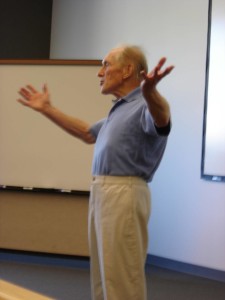
Warren Lamb (1923 — 2014) became one of Laban’s first students in England after a chance meeting in 1946 encouraged Lamb to abandon a career in banking and pursue the study of dance and movement. Along with these studies, Lamb became Laban’s protégé in the analysis of manual labor in British factories. Laban had begun to apply movement analysis to the study of clerical and managerial jobs. Lamb drew upon this pioneering work when he opened his own management consultancy in 1952.
Over the next dozen years, Lamb worked assiduously to clarify movement assessment methods, interviewing hundreds of managers. By 1965, he had established firm connections between patterns of movement behavior and decision making processes. His disciplined study of movement yielded individual “action profiles” useful for selection, placement, career development, and team building.
Movement Pattern Analysis (MPA), as Lamb’s work has come to be known, has an impressive track record. Over 400 companies around the world have employed MPA profiles to build successful management teams. The insight into behavior obtained through movement profiling is so valuable that many of these enterprises have utilized MPA for over three decades.
Throughout his long career, Warren Lamb has insisted that movement – recognized in its true sense as a constant process of variation — should be regarded as a subject in its own right. Since movement is part of every activity, Lamb has advocated that it be studied in a multi-disciplinary fashion. While most of his professional activity has been in industrial and commercial fields, Lamb has worked with a wide variety of people – sculptors, artists, musicians, actors, teachers, therapists, and psychiatrists. In addition, his lengthy collaboration with other movement study pioneers, notably Irmgard Bartenieff and Judith Kestenberg, has profoundly influenced the course of movement analysis in the U.S.
